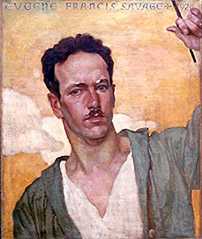Eugene Savage
| Eugene Francis Savage | |
|---|---|
 Self portrait of Eugene Francis Savage, 1924 | |
| Born |
1883 Covington, Indiana |
| Died |
1978 Woodbury, Connecticut |
| Nationality |
|
| Field | painting, murals |
| Training | Chicago Art Institute, American Academy in Rome, Yale University |

Eugene Francis Savage (Covington, Indiana, 1883 — Woodbury, Connecticut, 1978[1]) was an American painter and sculptor known for his murals in the manner made official under the Works Projects Administration. He also is known for his work on the Bailey Fountain in Grand Army Plaza, Brooklyn, New York.
He was born in Covington, Indiana. In 1915,[2] while studying at the Chicago Art Institute, he won the Rome Prize in painting, enabling him to study at the American Academy in Rome, where he received a bachelor of arts degree. Later he received bachelor (1924) and master of fine arts degrees from Yale, where he taught for twenty-eight years. While acting as a member of the Fine Arts committee of the American Academy in Rome, he ensured, though not a member of the jury, that a generation of winning artists were painting in the manner of Thomas Hart Benton or Savage himself.[3] He became an Associate Member of the National Academy of Design, 1924 and National Academician, 1926.[4] Other contemporary influences on his public art were his Latin American contemporaries Diego Rivera and José Clemente Orozco. Savage also served on the U.S. Commission of Fine Arts from 1933 to 1941 and was a member of the American Academy of Arts and Letters, to which he was elected in 1936.[5][6]
Murals by Savage are on the campuses of Purdue, Columbia and Yale Universities[7] and in public buildings in Connecticut, the Elks National Veterans Memorial in Chicago, the new Post Office Building (now Ariel Rios Federal Building) in Washington, in Indiana and the renovated Court of Appeals Hall, Albany, New York (1959). He also did the Great Hall murals in the Hall of State at Fair Park for the 1936 Centennial Exposition in Dallas, Texas.

In 1935 and 1953 Savage visited Florida, where he painted the experience of the Seminole Indians in their Everglades habitat especially taking note of the intrusion of modern civilization into what seemed to be a Garden of Eden pastoral existence. These paintings were done at the same time the effort was under way to create the Everglades National Park[9]
References
- ↑ Dates and places are as given in David Bernard Dearinger, Paintings and Sculpture in the Collection of the National Academy of Design:Vol. 1 : 1826-1926 (2004), s.v. "Eugene Francis Savage" (pp 492f).
- ↑ American Academy in Rome, Society of Fellows, under 1915; the date is often given as 1912.
- ↑ Thus the students were known as "little Savages", according to Time Magazine, "Prix de Rome", 23 May 1932
- ↑ "Eugene Savage: festival of the Sea"; Eugene Savage: Self-portrait
- ↑ Deceased members
- ↑ Thomas E. Luebke, ed., Civic Art: A Centennial History of the U.S. Commission of Fine Arts (Washington, D.C.: U.S. Commission of Fine Arts, 2013): Appendix B, p. 554.
- ↑ In the Sterling Memorial Library, where he was in charge of the painted decorations.
- ↑ Lynn Blocker Krantz, Nick Krantz, Mary Thiele Fobian, To Honolulu in Five Days: Cruising Aboard Matson's S.S. Lurline 2001.
- ↑ AskArt.
- Berenson, Richard J. (ed), The Complete Illustrated Guidebook to Prospect Park and the Brooklyn Botanic Garden, New York, Silver Lining Books, New York, 2001, ISBN 0-7607-2213-7, pages 32–36.
- Lancaster, Clay, Prospect Park Handbook, New York, Published for Greensward Foundation by Long Island University Press, 1972, ISBN 0-913252-06-9.
External links
- Covington Community Foundation
- Purdue University, "The Spirit of the Land Grant College" mural, 1961.
|